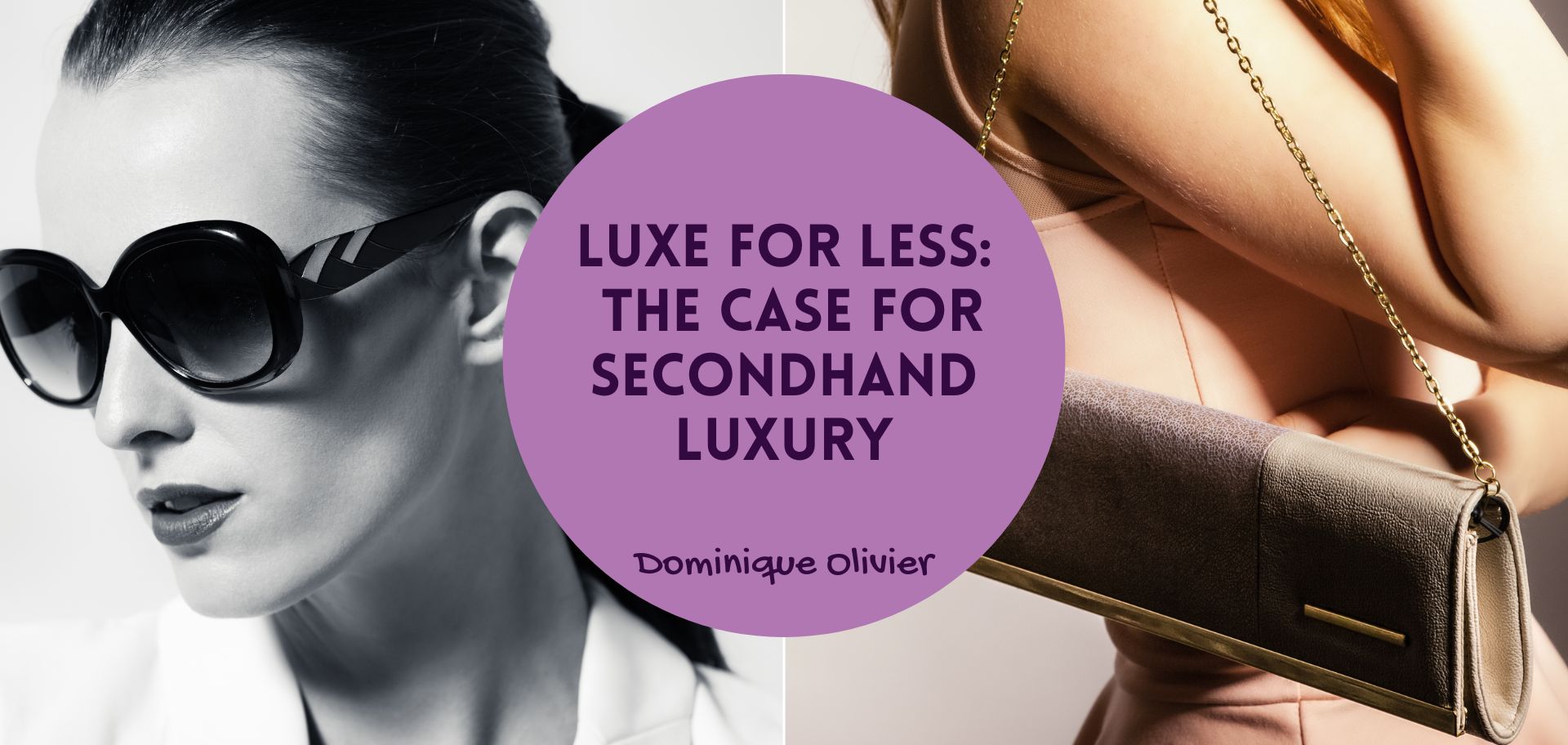Due to elevated cost of living pressures, fashionistas around the globe are having to tighten their belts. Make no mistake – those belts are still designer. Consumers are just getting smarter at paying less for them.
As a fashion enthusiast on a budget, I never thought the day would come where I would be able to afford anything from the lauded house of Prada. And yet, this week, I made a personal dream come true when I bought myself a beautiful pair of Prada sunglasses. How is this possible on a writer’s earnings? The answer is simple: I got them secondhand.
Yes, thanks to a lot of patient searching and the miracle of the internet, I bought a pair of designer sunglasses for approximately 25% of the price that I would have paid in-store. They are in perfect condition and their authenticity has been verified. All I had to do was to wait for someone to pay the full price for them first, and then decide to sell them.
If this is your first introduction, then welcome to the wonderful world of secondhand luxury.
Macklemore and me
The year was 2012, and American hip-hop duo Macklemore and Ryan Lewis’s saxophone-driven earworm, “Thrift Shop” had just landed. As someone who had just discovered the magic of charity shops and flea markets, I felt that the song had been written for me. My thrifting habit, which had started as a way to access affordable clothing as a broke student, had quickly morphed into the understanding that I could get branded, better-quality clothing at cheaper prices than the new stuff at the mall, if only I was willing to dig for the gems inbetween rails of mediocre hand-me-downs.
Sure, sometimes I would come across an item of clothing that was stained, that smelled funny or that needed a bit of repair. But with a little bit of elbow grease and a lot of OMO, I found that I could restore practically any item of clothing to its former glory – and then revel in that glory knowing that I had paid peanuts for it.
I was not alone in this discovery, of course, and that’s part of the reason why “Thrift Shop” was such a hit. At its core, the song spoke to a generation of young consumers who were rejecting the notions of embarrassment and shame that were previously attached to secondhand clothing. Thrifting became cooler than ever before – a counterculture way of sticking it to big labels while looking fabulous and saving money, all at the same time. Secondhand marketplaces started popping up online, and Instagram pages dedicated to the resale of clothing became a dime a dozen. In no time at all, the thrift shop became a digital entity. Forget about e-commerce. This is recommerce.
In 2023, approximately one third of clothing and apparel items purchased in the US were secondhand. The global secondhand apparel market is currently worth $177 billion, up 28% from 2021. By 2027, the same global market is expected to grow to $350 billion.
That’s a lot of secondhand jeans.
It’s not all grunge though
It might surprise you to learn that of the global secondhand apparel market, about a third is made up of luxury goods. In 2023, Bain & Company estimated that approximately $49.3 billion worth of secondhand luxury goods were sold globally.
The emergence of online resellers like the RealReal and Vestiaire Collective has significantly enhanced accessibility to pre-owned designer items. Consequently, the resale market has expanded twofold over four years, now representing 12% of the value of the new luxury goods market.
In my example of the Prada sunglasses, I paid less for the item than I would in-store, which makes sense to me, because I know that I am buying something pre-owned. What surprised me in my research is that some luxury items can actually fetch a higher price secondhand than they would brand new. For example, certain Hermès items not only retain their value but can command a significant premium on the secondary market. In fact, the brand’s pre-owned handbags can fetch prices up to 25% higher than their original retail value. Likewise, pre-owned timepieces from Rolex and Patek Philippe often sell at average premiums of 20% and 39%, respectively.
A lot of this has to do with the limited release of luxury items. When Hermès only makes 500 of a certain scarf before discontinuing it forever, there is no option to buy a new one in the store. In a classic case of demand surpassing supply, resellers are then free to name their prices.
Most brands experience a decline in resale value, however. Over the past year, the secondhand value of products from Gucci, Balenciaga and Bottega Veneta has decreased by 10%, 14% and 23% respectively. When resold, handbags by Louis Vuitton typically lose an average of 40% of their original value, while Christian Dior’s bags nearly depreciate by half. As you can imagine, this is great news for consumers in the secondhand market.
Can luxury brands get a slice of this pie?
What’s more lucrative for a luxury brand than selling an item once? Selling it twice, of course!
A number of luxury brands have already woken up to the idea that their wares have a significant resale value, and are striving to insert themselves into the circular economy. Some do this by collaborating directly with the resale platforms – Burberry, for instance, has partnered with Vestiaire Collective, while Gucci has sided with The RealReal. Some have gone even further and established their own resale platforms. Rolex is a great example of this. Their certified pre-owned watch programme provides discerning customers with timepieces that have been authenticated and serviced by their own watchmakers, adding a layer of reassurance and trust that might just be enough to lure consumers away from private sales and back into the fold.
The trick to success in this game is volumes. While high-value, low-volume brands like Rolex and Hermès are capable of making a “second profit” off their items, clothing designers and handbag manufacturers are not so lucky. Because their volumes are higher, they would have to repurchase substantial quantities of pre-owned inventory for this approach to be successful in their own stores or on their own platforms, which causes all kinds of other problems for the vast manufacturing capacity they have built to produce new items.
It’s a generational thing
Earlier in this article, I mentioned that the rise in thrifting in the early 2010s was primarily driven by the fact that perpetually-broke Millennials were flocking to thrift stores instead of shopping malls. Now, we’re seeing how the next generation, Gen Z, is embracing secondhand shopping as a result of their strong focus on sustainability.
For better or worse, Gen Z is the generation that was raised with the ever-present threat of global warming and ecological decline in their peripheral vision. All that fear, combined with a healthy dose of greenwashing, has created a generation that has demonstrated a strong preference for sustainable brands, with some showing a willingness to pay as much as 10% more for an item that they believe to be more sustainable.
Unsurprisingly, 75% of Gen Z consumers also prioritise sustainability over brand recognition when making clothing and apparel purchases. And what’s more sustainable than buying what already exists, instead of creating demand for new items, which require resources to produce? That explains why, according to eBay’s second annual Recommerce Report, a staggering 80% of Gen Z consumers are actively seeking out and purchasing pre-owned items.
I’m not the head of strategy at Prada (thankfully), but if I were, I would be paying particular attention to these statistics and considering what they mean for my brand in the long term. In a recent survey of affluent consumers, those under the age of 40 strongly agreed that buying secondhand was a sustainable choice, with just under half of participants in the same age group reporting that they are currently buying pre-owned luxury goods.
It’s not looking like a particularly bright future for luxury brands that can’t adapt to compete with their own secondhand wares. As for me – I’ll be smiling all summer long as I wear my favourite new sunglasses. And if I get tired of them, I can always just resell them.
About the author:

Dominique Olivier is the founder of human.writer, where she uses her love of storytelling and ideation to help brands solve problems.
She is a weekly columnist in Ghost Mail and collaborates with The Finance Ghost on Ghost Mail Weekender, a Sunday publication designed to help you be more interesting.
Dominique can be reached on LinkedIn here.





Hi Dominique, love all your articles, all very ‘edutaining’.!
Many thanks.
Thanks for the comment Peter! Happy to be enterteaching 😉
Hi Dominique. Really enjoy reading your articles.
Keep them coming.
Cheers
Thank you for the kind words Sean! I’m glad you’re liking what you’re reading. I certainly have no plans to stop anytime soon!
Great article Dominique.
Creating or accessing markets is essential for successful retailing (or reselling). The luxury brands you quote probably knew that there was a thriving second hand market for their goods but didn’t know how to access it. The thrift shops did. The luxury brands then jumped on the bandwagon, giving authenticity to the second hand goods being sold. A perfect symbiotic relationship.
It’s the same in our private lives, as anyone who has ever, futilely, tried to sell a pair of old but serviceable shoes has found. Just give those shoes to your housekeeper or gardener and the very next day they will be on sale on the pavement of some informal settlement, earning an income for somebody.
You’re absolutely right Tim. Of course the biggest winner in all of this are the consumers (like me!) who score designer items at massive discounts on the secondhand market.
Charity shops or, as you call them, thrift shops, are a great source of funds for non-profit organisations who struggle to make ends meet, especially if their resale stock is donated. I know of many people who only purchase from charity shops, especially for clothing and luxury items.
You’re absolutely right Barbara! Nothing feels quite as good as paying a reduced price for luxury and knowing the funds go to a good cause as well.